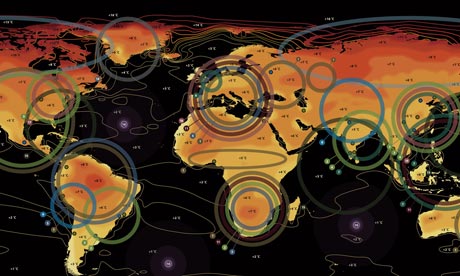 Science Museum unveils climate change map showing impact of 4C rise
Oct 22, 2009 - David Adam and Allegra Strtton - Guardian.co.UK The map shows the impact of an average 4C rise in global temperature, which John Beddington, the government's chief scientist, said would be "disastrous". A study by the Met Office last month said that such a 4C rise could come as soon as 2060 without urgent and serious action to reduce emissions. The map was launched to coincide with the London Science Museum's new Prove it climate change exhibition by David Miliband, foreign secretary and his brother Ed Miliband, energy and climate change secretary. It comes in advance of key political talks on climate change in December in Copenhagen, where British officials will push for a new global deal to curb emissions. The Miliband brothers said a new deal needed to be strong enough to limit global temperature rise to 2C, although many involved in the negotiations privately believe this to be impossible. A joint press release from the government and the Met Office released to promote the map says the government is aiming for an agreement that limits climate change "as far as possible to 2C". The map's release marks a significant shift in political discourse on climate change, with many politicians until recently unwilling to discuss the possibility of a failure to hit the 2C target. David Miliband warned today that the Copenhagen talks were "the most complicated international negotiations ever attempted". He predicted that unless climate change was slowed there would be "high pressure" on water and food shortages. In their second joint press conference on international efforts to secure a fresh climate change deal in Copenhagen – now 45 days away – Ed and David Miliband stressed the danger posed by a political failure at the talks. "We cannot cope with a 4C world. This map clearly illustrates the scale of the challenge facing us today ... To tackle the problem of climate change, all of us, foreign ministries, environment ministries, treasuries, departments of defence, and all parts of government and societies, must work together to keep global temperatures to 2C," he said. Ed Miliband said: "Britain's scientists have helped to illustrate the catastrophic effects that will result if the world fails to limit the global temperature rise to 2C. With less than 50 days left before agreement must be reached, the UK is going all out the persuade the world of its need to raise its ambitions so we get a deal that protects us from a 4C world." The map, produced by the Met Office Hadley Centre, is based on temperatures between 2060 and 2100 if current rates of climate change are not slowed. It shows that the rise will not evenly be spread across the globe, with temperature rises much larger than 4C in high latitudes such as the Arctic. Because the sea warms more slowly, average land temperature will increase by 5.5C, which scientists said would shrink agricultural yields for all major cereal crops on all major regions of production. A 4C world would also have a major impact on water availability, with supplies limited to an extra billion people by 2080. It could also be very bad news for the Amazon, with some computer models predicting severe drying and subsequent die-back. One of the biggest, more subtle, effects could be on the way the world's oceans and ecosystems absorb carbon. About half of our carbon emissions are currently soaked up in this way, which helps put the brake on global warming. In a 4C world, scientists say the amount of emissions re-absorbed in this way could shrink to just 30%. |
